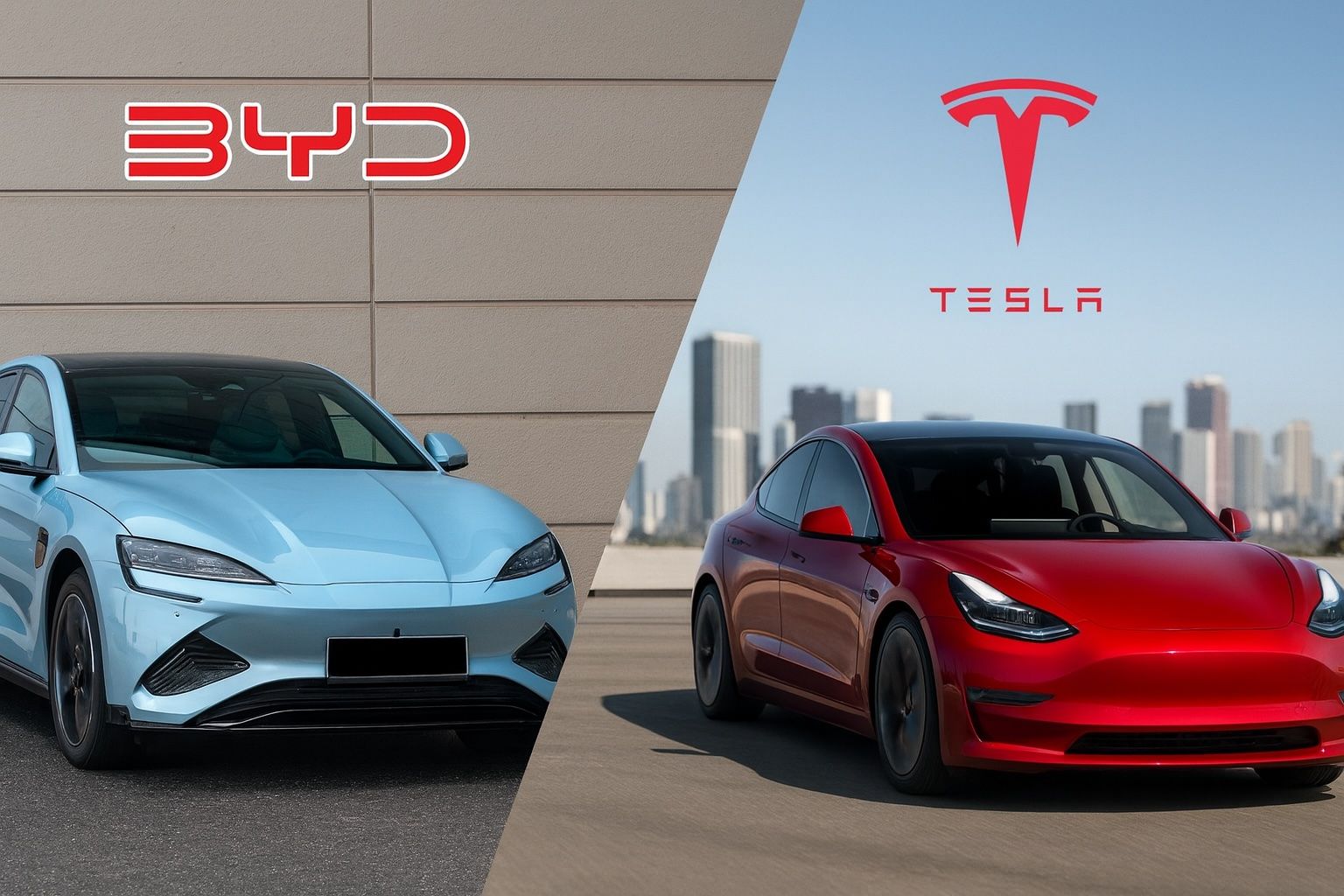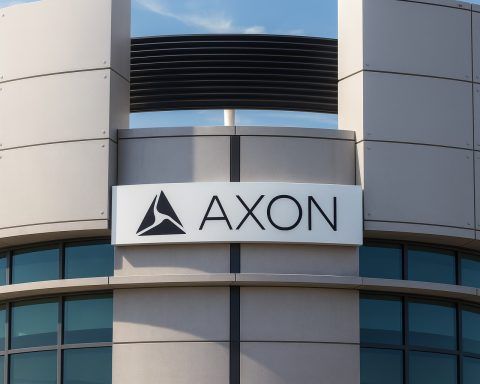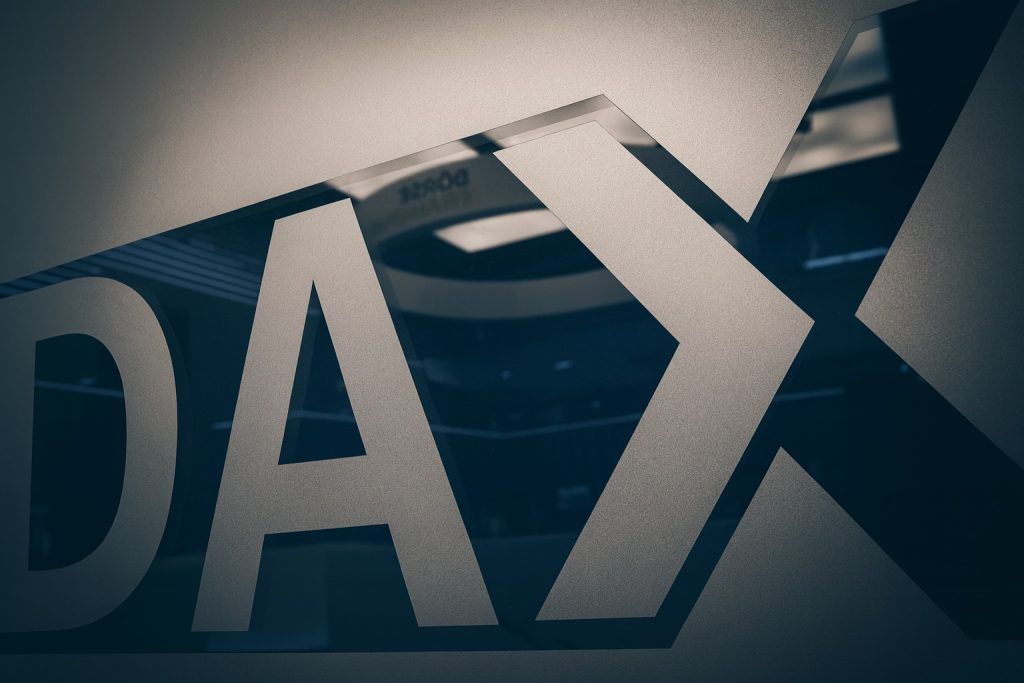- BYD’s profit crashes: Chinese EV giant BYD saw its third-quarter profit plummet by ~33% year-on-year, the steepest drop in over four years [1]. Net income fell to roughly 950 million euros, while revenue slipped ~3% to €23.6 billion [2] – BYD’s first sales decline in years amid cooling demand.
- Price war squeezes margins: A weak home market in China and aggressive price cuts triggered BYD’s earnings slump [3]. Rivals like Tesla, NIO, and Xpeng have slashed EV prices to grab market share, forcing BYD to follow suit at the expense of its margins [4]. BYD’s domestic market share shrank to 14% (from 18% a year ago) as competition intensifies [5] [6].
- Global growth accelerates: Outside China, BYD is surging abroad. European sales jumped 250% in the first half of 2025, with ~13,000 BYD EVs sold in the EU in September (+270% YoY) [7]. BYD expects exports to double in 2025, and is even starting production in Europe (new Hungary plant) this winter [8] [9]. International sales surged 160% in Q3 as demand in Europe and Latin America soars [10].
- EV powerhouse status: Once known for phone batteries, BYD has rocketed into the global top 5 automakers [11]. In 2024 it sold 4.27 million vehicles, and by H1 2025 BYD was already the world’s 4th largest car brand by sales [12]. Last year, BYD’s revenue topped $100 billion – even outpacing Tesla’s sales [13] – underscoring its rapid rise as Tesla’s fiercest competitor.
- Stock under pressure, outlook mixed: BYD’s shares tumbled after the earnings shock, falling ~4% over two days in Hong Kong [14]. Despite the setback, many experts call the sell-off overdone, citing BYD’s tech leadership (in-house batteries, chips, software) and solid fundamentals [15]. Analysts predict that if China’s market stabilizes and exports keep climbing, BYD could regain its growth trajectory by 2026 [16].
From Battery Maker to EV Titan: BYD’s Meteoric Rise
BYD (“Build Your Dreams”) has undergone a stunning transformation – from a humble battery producer into an electric vehicle powerhouse. The Shenzhen-based company, which started by making cellphone batteries, scaled its auto business to millions of units within a few years [17]. In 2024 BYD sold about 4.27 million vehicles, firmly cementing itself among the world’s top five automakers [18]. In fact, by the first half of 2025, BYD ranked #4 globally in passenger car sales – ahead of legacy giants like GM and Hyundai [19]. This surge marked a tipping point, with analysts noting a “structural power shift” as Chinese automakers like BYD displace Western rivals in volume [20].
Crucially, BYD leveraged a pragmatic, volume-driven strategy. Unlike Tesla’s pure battery EV approach, BYD sells both fully electric models and plug-in hybrids, covering price segments where many pure EVs can’t compete [21]. This broad lineup – from affordable city cars to luxury EVs – helped BYD conquer its home market and expand abroad. BYD’s vertical integration is another advantage: it produces its own batteries, chips, and other key components, driving down costs and speeding up model cycles [22]. By 2022, BYD had surpassed Tesla in domestic China EV sales; by 2024, BYD’s annual revenue topped $100 billion for the first time, even overtaking Tesla’s revenue that year [23]. As China’s EV market leader [24], BYD has been widely seen as Tesla’s fiercest global competitor, with Elon Musk himself acknowledging BYD’s impressive progress.
Biggest Profit Slump in Years Signals Trouble at Home
Despite years of breakneck growth, BYD is now hitting some speed bumps. In its latest earnings, BYD reported a profit collapse for Q3 2025 – down 32.6% year-on-year, marking a second straight quarterly decline and its sharpest drop in over four years [25] [26]. Net profit for the quarter was 7.8 billion yuan (about €950 million) [27] [28]. Revenues fell modestly (off ~3% YoY) to 195 billion yuan (~€23.6 billion) [29] [30], which is notable as BYD hadn’t seen a sales decline in over five years [31] [32]. The downturn is a stark contrast for a company that, until recently, was posting record growth each quarter.
Management attributed the earnings slump largely to deteriorating conditions in China, BYD’s core market. A combination of weakening demand at home and an escalating price war has eaten into both sales and margins [33]. BYD’s vehicle deliveries in Q3 2025 actually declined ~1.8% from a year prior, to 1.15 million “new energy” vehicles (counting EVs and hybrids) [34]. This is a small dip, but it’s significant because it’s BYD’s first year-over-year sales drop since 2020 [35] [36]. The slump even caused BYD to lose its crown as China’s top-selling automaker – in September 2025, state-owned SAIC Motor overtook BYD in monthly sales after BYD’s first sales decline in 18 months [37].
In response to the slowdown, BYD took the dramatic step of cutting its full-year sales target. The company lowered its 2025 sales goal by 16%, now aiming for 4.6 million vehicles instead of the ~5.5 million originally planned [38]. BYD also acknowledged that its massive production plants are seeing a downtrend in output as demand cools [39] [40]. These signs – shrinking profit, sliding market share, and scaled-back targets – all underscore that even China’s EV juggernaut is not immune to market headwinds.
Price War and Competition Erode BYD’s Lead
BYD’s troubles at home are part of a fierce price war gripping the Chinese EV market. The third quarter results laid this bare: intense domestic competition is squeezing BYD from all sides [41] [42]. Tesla, NIO, Xpeng, and other rivals have been slashing prices and rolling out special offers throughout 2023–2025 to spur sales [43]. “Manufacturers like Tesla, NIO and Xpeng outdid each other with price cuts and promotions… BYD had to follow suit – at the cost of its own margins,” one analysis noted of the recent trends [44]. These aggressive tactics have made new electric cars more affordable for consumers, but they are hammering automakers’ profit per vehicle.
The price war in China became so heated in 2023 that regulators voiced concerns it could become unsustainable. At its peak in mid-2025, the average discount on EVs hit a record 17.4% off list prices [45], according to JPMorgan research covering dozens of brands. Although discounts eased slightly later (stabilizing around 16–17% off by Q3) [46], profit margins remain under heavy pressure. BYD itself launched new rounds of hefty incentives on models like the Qin Plus sedan in recent months to defend its sales lead [47] [48]. About 80% of BYD’s vehicles are sold in China [49], so any domestic price war directly hits its bottom line. “A weak demand in China and strong price concessions led to BYD’s profit collapse in Q3,” reported FOCUS Online, highlighting how steep discounts eroded earnings [50].
Meanwhile, local competitors are seizing the moment. Some Chinese automakers have actually thrived amid the price cuts. In Q3, Geely’s sales rocketed +96% and Chongqing Changan’s by +84% year-on-year [51] – dramatic growth that far outpaced BYD’s slight decline. Upstarts like NIO and Xpeng remain smaller in volume but are rapidly innovating and undercutting on price in certain segments. Even foreign brands like Tesla are aggressively pushing in China with repeated price reductions on popular models. The net effect is that BYD’s once-dominant market share has been chipped away: it slid to ~14% in September, down from 18% a year prior [52] [53].
The competitive onslaught and shrinking margins have alarmed industry observers – and even the Chinese government. Officials earlier this year called on automakers to avoid “unsustainable” price wars, worried that a prolonged profit squeeze could hurt the industry’s health [54]. So far, these pleas have had limited impact; discounts remain common as brands jostle for buyers [55]. BYD finds itself walking a tightrope: it must defend its turf in China (sometimes by sacrificing profit), even as it looks abroad for new growth.
One silver lining: analysts suspect part of BYD’s recent slowdown is strategic. Citi analysts noted BYD has been deliberately cutting back on production to reduce excess inventory ahead of major new model launches in 2026 [56]. Both absolute and relative inventory levels fell in September, indicating BYD was clearing stock of older models [57]. “With lower inventory, [BYD] could regain market attractiveness through relatively stable margins and cost advantages,” said Jeff Chung, a Citi analyst covering BYD, especially if its export portfolio strengthens in early 2026 [58]. In other words, BYD might be enduring short-term pain (lower sales now) in order to support a healthier, more profitable growth when its next-generation EV models roll out.
Betting on Global Expansion: Europe, Emerging Markets & Upmarket Moves
BYD’s answer to the domestic challenges is clear – go global, and go upscale. The company is aggressively expanding in overseas markets, seeing them as crucial to sustain growth. BYD’s leadership just projected that exports will roughly double in 2025 compared to 2024 [59], and that about 20% of BYD’s sales next year will come from outside China (up from ~10% last year) [60]. With Chinese demand plateauing, international markets are becoming BYD’s main growth engine.
Europe is a prime target. In the first half of 2025, BYD’s sales in Europe soared 250% year-on-year as the company ramps up its presence [61]. Although volumes are still modest, momentum is strong: in September alone, BYD sold 13,000 cars in the EU – a 272% jump from a year earlier [62]. These gains put BYD among the fastest-growing auto brands in Europe, where EV adoption is accelerating. Chinese automakers collectively have achieved record market share in Europe, even overtaking Korean brands for the first time [63], and BYD is at the forefront of this push. To support its European ambitions, BYD is investing in local production: this winter, it will start building electric cars at a BYD factory in Hungary [64]. It’s also planning a new battery plant in Europe [65], aiming to shorten supply chains and comply with local content rules.
Beyond Europe, BYD is making inroads in Asia and the Americas. In Japan – a market long dominated by Toyota and Honda – BYD is entering with a mini-EV designed specifically for Japanese consumers, showcased at the Japan Mobility Show [66]. In Southeast Asia and India, BYD is leveraging its affordable EV models to capture first-time buyers. Meanwhile, Latin America has emerged as another growth frontier: BYD’s sales in countries like Brazil and Mexico are climbing quickly [67]. The automaker is even establishing local assembly facilities in places such as Thailand, Brazil, and Mexico [68] to better serve those markets. This localized production is strategic – it helps BYD avoid import tariffs, cut shipping costs, and tailor models to local tastes, all of which boost its competitiveness abroad.
Crucially, overseas markets also offer fatter profit margins than China. Analysts estimate Chinese EV makers can earn roughly 4× more profit per car sold abroad than on a comparable car in China [69]. The reason: EV prices (and willingness to pay) are higher in Europe or North America, whereas China’s cutthroat competition keeps prices ultra-low. BYD hopes that selling more cars in Europe, Australia, Latin America, etc., will lift its overall margins. Indeed, BYD’s management has indicated it is focusing on higher-end models for export – including launching its luxury sub-brands Yangwang and Fangchengbao with premium EVs next year [70]. These luxury electric SUVs and sports cars will target affluent buyers and carry higher price tags (and margins) than BYD’s mass-market offerings.
So far, the global gamble seems to be paying off. BYD’s international sales jumped 160% in Q3 [71], helping offset some of the China slowdown. BYD is rapidly expanding its overseas dealer network and introducing new models like the Dolphin hatchback and Seal sedan to markets from Norway to Australia. Last month, thanks to new model launches and broader distribution, BYD’s European sales climbed sharply, even narrowing the gap with Tesla in some countries [72]. The company’s aim is not just volume growth, but also to establish BYD as a worldwide EV brand known for value and technology – effectively exporting its domestic success story onto the global stage.
Investor Jitters and Forecasts: Will BYD Bounce Back?
The recent hiccups have understandably rattled investors. After BYD announced its profit plunge, the stock took a hit. BYD’s Hong Kong–listed shares fell nearly 4% over two trading days [73] following the Q3 report. The stock closed at HK$104.20 after earnings (–0.6% that day), then slid further to HK$100.60 (–3.5%) by that Friday [74]. As the bad news sank in, traders on Shenzhen’s exchange likewise sent BYD’s yuan-denominated shares down. By early November, BYD’s stock was trending “southward” amid the earnings fallout and broader market weakness [75] [76].
Yet, despite short-term market angst, many experts remain upbeat about BYD’s prospects. Analysts note that BYD still has formidable strengths that haven’t disappeared in one weak quarter. “Many experts consider the setback exaggerated,” reported finanzen.net, emphasizing that BYD remains a technological leader in EVs [77]. The company’s vertical integration – from battery cells to semiconductors – gives it control over its supply chain that competitors envy [78]. BYD also spends heavily on R&D and has a diverse product range, positioning it well for a future where EV demand is only expected to grow globally.
Crucially, BYD’s long-term growth story is intact, provided it navigates the current turbulence. Automotive analysts point out that the core growth drivers for EVs (like the push for carbon neutrality and consumer preference for cleaner cars) are still strong. BYD’s sales are down but not out in China, and its order books in many overseas markets are growing. If the Chinese market stabilizes in 2024 and the brutal price war eases, BYD’s domestic sales could rebound – especially with new models coming that may rekindle consumer excitement [79]. Meanwhile, as exports rise from 10% to 20% of sales, BYD’s reliance on China will lessen, making it more resilient. Finanzen.net’s market experts suggest BYD could return to its “old growth path” as early as 2026, assuming its expansion plans bear fruit [80].
Some industry voices are already calling the recent stock drop a potential buying opportunity. Citi’s Jeff Chung argues that BYD’s proactive inventory and cost management will pay off soon, saying the company “could regain market attractiveness through…stable margins and cost advantages” once new models launch and exports expand [81]. In essence, BYD is resetting for its next growth chapter. It’s worth remembering that even after the dip, BYD’s share price is still up significantly over the past five years, reflecting the company’s dramatic rise. Long-term investors like Warren Buffett (whose Berkshire Hathaway has owned a sizable BYD stake since 2008) have historically seen turbulence as part of the ride in a high-growth industry.
For now, BYD faces a dual challenge: defending its dominance in China’s hyper-competitive EV arena, while proving it can conquer foreign markets. The coming quarters will test whether BYD can execute on its global ambitions without eroding profitability at home. The company is launching a slate of new EV models in 2024–2025, including high-profile luxury EVs and affordable mass-market cars, to rejuvenate sales. It’s also lobbying for policy support – e.g. incentives in export markets and a cooling of China’s price wars – to create a more favorable business environment.
The stakes are high. BYD’s stumble has been a reality check for the EV sector, showing that even the mightiest players aren’t immune to industry cycles. But with its sheer scale, technological edge, and international reach, BYD is still poised to challenge Tesla and the global auto establishment in the long run. As one headline put it, BYD is down “but by no means out” [82]. If it can weather the current storm, BYD may emerge stronger – making good on its promise to “build your dreams” and perhaps even giving Tesla a run for its money on the world stage.
Sources:
- Maria Glaser, Elektroauto-News.net – “BYD: Größter Umsatzrückgang seit Jahren” (Nov 4, 2025) [83] [84] [85]
- Reuters – “China’s BYD reports biggest quarterly profit fall in over four years” (Oct 30, 2025) [86] [87]
- FOCUS Online – “Gewinn von BYD bricht um 33 Prozent ein” (Nov 3, 2025) [88] [89] [90] [91]
- finanzen.net – “BYD-Aktie im Fokus:… Top 5… schärfster Tesla-Konkurrent?” (Nov 3, 2025) [92] [93] [94]
- finanzen.net – “BYD-Aktie unter Druck: Warum… plötzlich schwächelt” (Oct 31, 2025) [95] [96] [97]
- Teresa De Alba, Mexico Business News – “BYD Posts 33% 3Q25 Profit Decline; Rivals Gain Ground” (Oct 30, 2025) [98] [99] [100] [101]
References
1. www.focus.de, 2. www.focus.de, 3. www.focus.de, 4. www.finanzen.net, 5. www.reuters.com, 6. www.reuters.com, 7. www.focus.de, 8. www.focus.de, 9. www.reuters.com, 10. mexicobusiness.news, 11. www.finanzen.net, 12. www.finanzen.net, 13. www.focus.de, 14. www.finanzen.net, 15. www.finanzen.net, 16. www.finanzen.net, 17. www.finanzen.net, 18. www.finanzen.net, 19. www.finanzen.net, 20. www.finanzen.net, 21. www.finanzen.net, 22. www.finanzen.net, 23. www.focus.de, 24. www.focus.de, 25. www.elektroauto-news.net, 26. www.reuters.com, 27. www.focus.de, 28. www.reuters.com, 29. www.focus.de, 30. www.reuters.com, 31. www.reuters.com, 32. www.reuters.com, 33. www.focus.de, 34. mexicobusiness.news, 35. www.elektroauto-news.net, 36. mexicobusiness.news, 37. mexicobusiness.news, 38. www.reuters.com, 39. www.elektroauto-news.net, 40. www.reuters.com, 41. www.reuters.com, 42. www.reuters.com, 43. www.finanzen.net, 44. www.finanzen.net, 45. mexicobusiness.news, 46. mexicobusiness.news, 47. www.reuters.com, 48. www.reuters.com, 49. www.reuters.com, 50. www.focus.de, 51. mexicobusiness.news, 52. www.reuters.com, 53. www.reuters.com, 54. mexicobusiness.news, 55. mexicobusiness.news, 56. mexicobusiness.news, 57. mexicobusiness.news, 58. mexicobusiness.news, 59. www.reuters.com, 60. mexicobusiness.news, 61. www.focus.de, 62. www.focus.de, 63. www.finanzen.net, 64. www.focus.de, 65. www.elektroauto-news.net, 66. www.reuters.com, 67. www.finanzen.net, 68. www.finanzen.net, 69. mexicobusiness.news, 70. mexicobusiness.news, 71. mexicobusiness.news, 72. mexicobusiness.news, 73. www.finanzen.net, 74. www.finanzen.net, 75. www.finanzen.net, 76. www.finanzen.net, 77. www.finanzen.net, 78. www.finanzen.net, 79. www.finanzen.net, 80. www.finanzen.net, 81. mexicobusiness.news, 82. www.finanzen.net, 83. www.elektroauto-news.net, 84. www.elektroauto-news.net, 85. www.elektroauto-news.net, 86. www.reuters.com, 87. www.reuters.com, 88. www.focus.de, 89. www.focus.de, 90. www.focus.de, 91. www.focus.de, 92. www.finanzen.net, 93. www.finanzen.net, 94. www.finanzen.net, 95. www.finanzen.net, 96. www.finanzen.net, 97. www.finanzen.net, 98. mexicobusiness.news, 99. mexicobusiness.news, 100. mexicobusiness.news, 101. mexicobusiness.news













